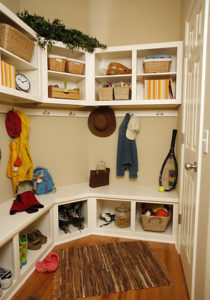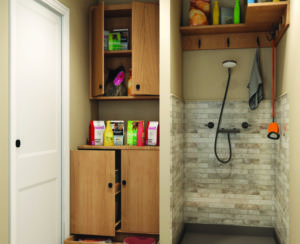
by Michele Weaver | Jan 10, 2020 | HER Home
Depending on the design of your home and its roof, water run-off can be a major problem for your driveway. Take for instance this home: no gutters on the front side over the garage. Yet two dormers over the garage form a “V”-shaped area directing rainwater off the roof and onto the driveway. No problem until winter. During the day, snow melt from the roof drips onto the drive. At night it would freeze. For most of the winter there will be icy driveways.

The Clarinda (#43020) as built by Fox Builders - downspouts on each side of the garage to divert water flow.
Another configuration that could present a hazard as well as concrete damage: a gutter downspout that empties between the garage doors. This directs water off the roof nicely, but again in the winter, creates ice problems on the driveway. And, the year-‘round diversion of water onto that portion of the driveway causes lots of concrete settling problems resulting in a very uneven driveway.
The solution in both instances is to place gutters and downspouts that direct the water to the side yard instead of the driveway. Thus, keeping your driveway from building up with ice in the winter, and maintaining the integrity of the concrete all year.
For more resources on thoughtful design:
Cover Photo: <a href="https://www.freepik.com/free-photos-vectors/winter">Winter photo created by freepik - www.freepik.com</a>

by Michele Weaver | Jul 22, 2019 | Great Design
It’s an oft-repeated tune – a national home builder moves into the marketplace, with eyes on becoming the dominant builder, or fast tracks the process by simply acquiring an established local builder. Thoughts of big-box stores moving in and local merchants going out of business ring true. After all, the nationals have the advantages of buying power, huge marketing budgets, lots of working capital, and better access to credit.
But…national builders typically don’t choose to compete on better, only cheaper. They’re playing to their strengths. So, why would you choose to compete using their rules for playing the game? You’re not going to win, consistently, on price.
What if, instead, you could write the rules?
With such a large purchase, price is always important. People use price as a tool for comparison. It helps when trying to make sense of different homes’ different prices. But do you want prospective buyers looking for negatives (reasons why the home is cheaper) or positives (attributes and amenities that help justify the higher price)? And, “cost per square foot?” You probably have your answers for that issue, but a third-party resource will be perceived as less biased. Download the Her Home™ Magazine’s “10 Things You Need to Know Before Comparing Cost Per Square Foot” article here.
Choose Local
Local builders are joining buying co-ops and even joining forces to acquire building lots to be more competitive with national builders. But even nicer is focusing on why your customers get a better value buying their new home from you. Playing to your strengths:
- You’re local. You know your local market; you may have grown up in your local market; you’ve put down roots there; and, you live there. You have existing relationships with others in your local market. From sponsoring local sports teams to being a co-presenter along with a local lender and Realtor®, you are engaged in the community, and that matters.
- You’re human. What home buyer would ever meet with the president or owner? Buyers want to work with a builder they can trust, and it’s much easier to trust a person than a corporation.

- Your reputation. Review sites are full of disgruntled home buyers who bought “lowest price.” Your personal involvement with the buyers, use of quality materials and sub-contractors, and involvement in the community help people want to work with you rather than setting for working with you. Local builders won’t survive without high levels of customer satisfaction, which is the formula for referrals, the most profitable source of new customers.
- Your focus. You can’t be all things to all buyers. But you can be the best at the niche or target market you choose. High-performance? Eco-friendly? Tech-savvy? Woman-Centric? Differentiation takes the focus off price, and places it on the emotional appeals of the home and how it will feel to enjoy it. Conversely, the less you differentiate, the more price-sensitive you can expect prospective buyers to be.
- Bragging rights. Don’t limit your focus to mere rational appeals and attributes. Sure, people want lower utility bills, but they’ll love bragging about them – making sure others know they made a great purchase decision. Cutting dependence on maintenance and rescue medicines by building a healthy home speaks to caring, nurturing, making you feel good about your purchase. And, you’ll tell everyone about the difference breathing easier makes! Such attributes help people feel they got a great home and therefore a great deal; and, people are much more likely to brag about a great deal than about getting the cheapest price.
- New home searches begin online, and digital space levels the playing field. While the big nationals buy billboards, you can win online with quality local content. Each time you post a new blog, you can add a link to it on your social media profiles. Short-staffed? This can be hired out.
- It’s not just awareness, blogging helps position you as a local expert. Buyers want to make informed decisions, and they’re looking for answers. Developing a few downloadable tip sheets can further help overcome online anonymity, as prospects provide their contact information in exchange for your tips, and you can follow up with knowledge of a specific interest area that prospective buyer has.
Furthermore, national builders’ inherent weaknesses can be advantageous to you. They’re often interested only in larger tracts of land. Local builders may be in a better position to acquire smaller parcels, infill sites, or build on the owner’s land. Due to their structure, national builders can be low to respond, regimented, and bogged down in policies, procedures, and red tape. And, national builders face pressures on profitability, too. The difference is local builders are committed to their market, employing unbridled creativity and flexibility during down cycles. National builders can, and do, exit a market as quickly as they entered it – leaving vendors, sub-contractors, lenders, and yes, even their customers, to fend for themselves.
At Design Basics, we have the tools to help you stand out from the national builders
Contact us today to learn more. 800.947.7526

by Michele Weaver | Jan 9, 2019 | Great Design
“Half the money I spend on advertising is wasted.”
“…the trouble is I don’t know which half,” uttered back in the 1800s by John Wanamaker, the Philadelphia marketing pioneer whose department stores ultimately became part of Macy’s; Wanamaker’s words still ring true today. Ironically, at the exact time prospective new home buyers are actively seeking information to help them make the best new home purchase, too many messages fail to engage.
Left-brain/right-brain theory suggests words and information reside in the left hemisphere of the brain, associated with logic and rational thinking. Sometimes called the “emotional brain,” the right hemisphere is home to pictures, feelings, and her sense of identity. And we know buyers buy on emotion and subsequently justify those purchase decisions rationally. I’m an avid reader of Motor Trend. Many of the car ads are predictable – a beauty shot of the automobile, some text… Would anyone really notice if you were to swap out the photo of the car and the manufacturer ID? However, Volkswagen’s ad for their parking assist was different:
This Volkswagen ad doesn’t even show the product! Rather, it addresses a feature (Park Assist), implies the benefit (making parallel parking safe and easy), and is emotional (humorous).
Okay, your turn. Much home builder advertising seems almost “templated,” focused on a beautiful photo of the home (exterior or interior), informative text meant to differentiate, and company identification. The beauty photo might attract attention, but is the ad memorable and engaging?
Alternatively consider:
Main visual: Worried, wide-eyed 8-year old. Headline: “Mom, have you seen my _____?” Secondary visual: The lockers/cubbies in the rear foyer of your home. Secondary  text: Cubbies/lockers provide organization, helping get everyone out the door on time in the morning.
text: Cubbies/lockers provide organization, helping get everyone out the door on time in the morning.
Main visual: Woman wrapped in towel, smiling, standing in entry to door-less walk-in shower, holding squeegee. Headline: No door to clean! Secondary visual: Bathroom layout illustrating walk-in shower. Secondary text: Giving you back a little more time.
 Main visual: Baby napping. Headline: Another reason to chose the “Serenity Package.” Secondary text: Peace and quiet is a beautiful thing. You’ll never regret opting for the Serenity Package with (highlight a few of the product upgrades included, such as quiet appliances, bath fans, garage door opener, etc.).
Main visual: Baby napping. Headline: Another reason to chose the “Serenity Package.” Secondary text: Peace and quiet is a beautiful thing. You’ll never regret opting for the Serenity Package with (highlight a few of the product upgrades included, such as quiet appliances, bath fans, garage door opener, etc.).
Main visual: Adorable, muddy dog staring up at you. Secondary visual: Your home’s optional pet center. Text: Appreciating everyone in your household.
Each of the above examples delivers on one of home buyer’s most-desired benefits – reducing stress. While most builders touting “quality-built,” “industry-leader,” and “customer-focused,” are essentially wasting their advertising dollars (what builder doesn’t say those things?). Ads focused on the concepts and benefits customers seek, without the overused exterior/interior beauty photos are emotional, engaging, and drive decision making!
In addition to innovative home plans, Design Basics can help you develop compelling ads that work. Let’s talk!

by Michele Weaver | Jul 17, 2018 | Great Design, Problems Solved
“It’s raining in the basement!” shouts my 10-year old son, looking up from his video game. Upstairs, our 13-year old daughter is lying on her bed, talking on the phone. The laundry room sink, where she had been washing delicates is still running…and still overflowing! And that the laundry room is on the second floor, with all of the bedrooms. I rush home to standing water and white mush, which used to be kitchen ceiling drywall, soaking into and through the wood kitchen floors. Carpet…pad…walls…floors… ceilings…all saturated. My wife arrives home, crying, “We’re going to have black mold!” A water remediation specialist deploys massive fans. Our brand-new dream home, so meticulously planned, was flooded. Oh, did I mention we had moved in just F-I-V-E days prior?
You weren’t there. In fact, that event happened over 15 years ago. Yet, I’m betting you felt my anguish. Such is the power of story. Uri Hasson, a researcher at Princeton, claims a story is the only way to activate parts in the brain so that a listener turns the story into their own idea and experience (Harvard Business). We actually see ourselves in a good story, and it turns out our brains are wired that way.
So, you better believe there’s a story behind the humble laundry room drain. And if that’s true, isn’t there a story behind almost everything in the home you’re selling? Facts and figures (3-bedroom, 2 ½ baths, 1,800 square feet), and even bulleted feature lists activate left brain functions where we “think in words.” But story activates both the left brain’s logic and the right brain’s feelings and imagination. Neuroscientists have discovered brain chemistry is partly responsible. Story triggers the release of oxytocin, associated with good feelings, emotions, and in particular, empathy, allowing us to connect with the story. A second brain chemical, dopamine, is also released as we engage in story. Dopamine helps in focusing our attention, aiding memory, and pleasure.

Photo by Skyloft Photography
Simply put: information educates; story sells. You’ve heard the expression “buyers buy on emotion and then justify those decisions rationally.” Story is the key. And how we tell those stories matters, too. A story we’ve personally experienced, such as my water event, are charged with emotion and believability. As such stories educate, and become memorable, we can help shape buyer’s opinions, especially with regard to the desirability of certain aspects of a particular home. Walking in from the garage, there’s a drop zone on your left. Sometimes, story is simply triggered by a question – “When you arrive home from a long day and your hands are full as you come in from the garage, where does everything end up?” Inevitably they answer, “On the kitchen counters/island/table,” which leads to your story about the drop zone. To your right is a pet center complete with elevated shower for small dogs. Simply having an adorable stuffed beagle there begins to tell the story. A couple of potted plants nearby tells another story – it’s a gardening center!
At the risk of overstatement, your success in new home sales hinges on your prowess as a storyteller. This is where your team becomes so important. Make an event of walking through the home together, in particular identifying things you do or offer in the home other builders don’t, and then share your thoughts/experiences/stories regarding those things. What you learn from each other will help you develop your storytelling. Similarly, as you tour prospective buyers through the home, certain amenities may trigger the buyer’s own stories, some of which will become gems you’ll retell.
As you consider new home designs to offer, think too about the stories they will tell. We can help. Call us when you’re looking for that next hot design and we’ll talk with you about some of that home’s inherent stories. Even better, have a Design Basics; storyteller come spend a morning with your sales team, walking through your model home(s), identifying and rehearsing stories to sell!

by Michele Weaver | Dec 19, 2017 | Great Design
Recent studies by the National Association of Realtors® and Zillow reveal about 90% of new home buyers are using the internet in their search process. In fact, the internet has replaced real estate professionals as the #1 source of information for today’s home buyers. Whereas before, new home shoppers talked with family, friends, co-workers, and agents about various home builders as part of their information gathering process, and then visited numerous builders’ model homes – today much of that search happens online.
Now for the bad news. Prospective home buyers are ruling you out based on your website. Like most other builder websites, you probably have some beautiful photos, a portfolio of home plans to review, a list of communities and/or available home sites, a couple testimonials, and an “about us” page. Perhaps something on your website piqued her interest…but how did her visit to your website make her feel about your company?
 More specifically, why should she buy from you? “We’re a family-owned custom builder that’s focused on quality and customer satisfaction,” you say. She got the same message from half of the other builder sites she visited. At this preliminary stage, most prospective buyers are simply looking to save time and minimize the risk of choosing the wrong builder – especially with some of the horror stories out there surrounding other home buying experiences.
More specifically, why should she buy from you? “We’re a family-owned custom builder that’s focused on quality and customer satisfaction,” you say. She got the same message from half of the other builder sites she visited. At this preliminary stage, most prospective buyers are simply looking to save time and minimize the risk of choosing the wrong builder – especially with some of the horror stories out there surrounding other home buying experiences.
We suggest something along the lines of a “Customer Bill of Rights” or, as in the following example, a tailored version of The 10 Commandments. For such a large purchase, prospects will take a couple minutes to learn what to expect if she chooses you.
The bottom line: builders tell us this approach works, and we can help you make it work, too.
Contact us today!







 text: Cubbies/lockers provide organization, helping get everyone out the door on time in the morning.
text: Cubbies/lockers provide organization, helping get everyone out the door on time in the morning. Main visual: Baby napping. Headline: Another reason to chose the “Serenity Package.” Secondary text: Peace and quiet is a beautiful thing. You’ll never regret opting for the Serenity Package with (highlight a few of the product upgrades included, such as quiet appliances, bath fans, garage door opener, etc.).
Main visual: Baby napping. Headline: Another reason to chose the “Serenity Package.” Secondary text: Peace and quiet is a beautiful thing. You’ll never regret opting for the Serenity Package with (highlight a few of the product upgrades included, such as quiet appliances, bath fans, garage door opener, etc.).



